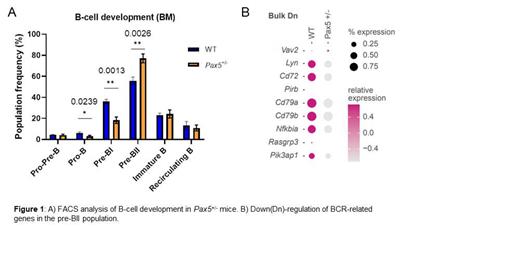Introduction: PAX5 is a well-known master regulator for B-cell development, commitment and identity. Hence, germline or somatic deregulation of PAX5 facilitates the development of B-cell precursor acute lymphoblastic leukemia (BCP-ALL). Previously, our group has described B-cell development abnormalities in three families carrying PAX5 germline variants ( Escudero et al., Leukemia, 2022) as well as established a link between Pax5 heterozygosity and infection exposure, thereby recapitulating the incomplete penetrance of the human BCP-ALL ( Martin-Lorenzo et al., Cancer Discovery, 2015). Nevertheless, the molecular single-cell characteristics of the susceptible precursor population mediated by reduced Pax5 levels is still poorly understood.
Methods: Here, we deeply characterized the susceptible precursor population in Pax5+/- mice utilizing single-cell RNA Sequencing (scRNA-Seq), multicolor flow cytometry analyses and in-vivo transplantation models.
Results: Our data show, that Pax5 heterozygosity leads to an aberrant pre-BII population (B220 +CD19 +IgM -CD25 +) in the bone marrow (BM) of Pax5+/- mice (p=0.0026, Student's t-test) (Fig. 1A). This population is stable over time and characterized by higher CD25 and IL-7-Receptor expression (p<0.0001, Student's t-test).
Furthermore, bulk RNA-Sequencing of the pre-BII population revealed B-cell receptor (BCR) signaling as one of the top downregulated pathways (including CD79a/b, Lyn and CD72), while DNA replication and cell cycle signaling pathways were upregulated in Pax5+/- vs. Wildtype (WT) pre-BII cells. ScRNA-Seq analyses confirmed these results (Fig. 1B) and further showed that pre-BII cells of Pax5+/- mice are skewed toward the less commonly used lambda light chain BCR-rearrangements.
The observed delay in the transition to IgM-positivity was additionally validated in a murine in-vivo transplantation model. Here, after 72 hours pre-BII cells from Pax5+/- mice preferably homed to the BM, while matured transplanted WT cells were predominantly found in the spleen (p=0.0023 and p=0.0140, respectively, Student's t-test). To depict the full spectrum of malignant transformation based on the described deregulated precursor B-cell population, we additionally performed scRNA-Seq on different stages of Pax5-mediated BCP-ALL evolution. Our data show that in a first step, arrested pre-leukemic cells of Pax5+/- mice lose their B-cell identity and display high Myc levels. Sequentially, full blown BCP-ALL arises in a second step after acquisition of additional oncogenic driver mutations (including Jak1 and Jak3). Interestingly, although the analyzed BCP-ALLs of Pax5+/- mice were all based on the same predisposition, they greatly varied in their transcriptional profile and cell-cycle state, depending on their oncogenic 2 nd hit.
Conclusion: In summary, we deeply characterized how reduced Pax5 transcriptional activity in the BM generates a predisposed precursor B-cell environment, which is susceptibility for malignant transformation. These findings are important for understanding the molecular mechanisms to prevent or treat a significant proportion of childhood BCP-ALLs.
Disclosures
No relevant conflicts of interest to declare.


This feature is available to Subscribers Only
Sign In or Create an Account Close Modal